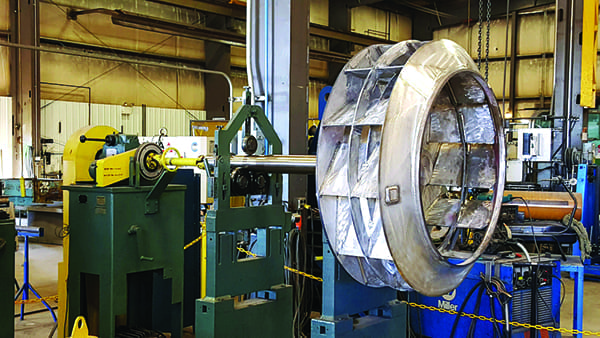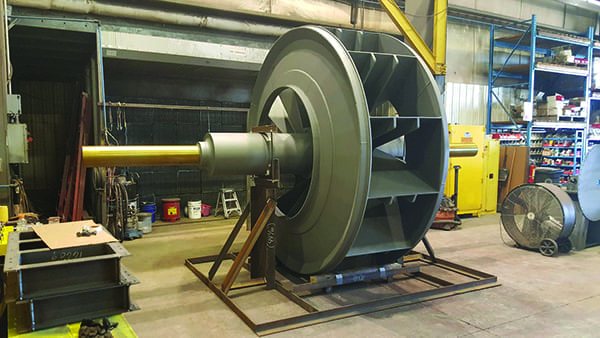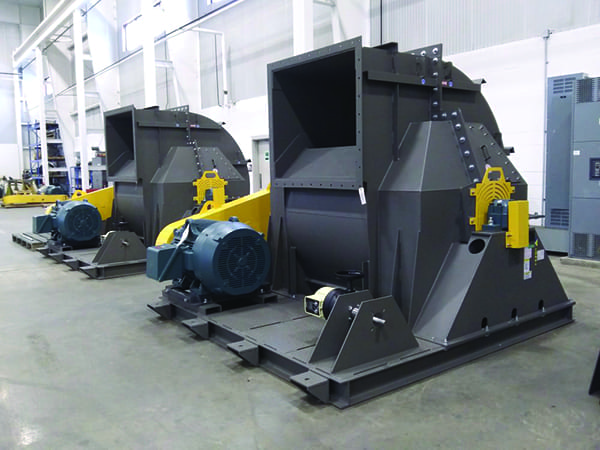Understanding Fan Problems and Optimizing Rotor Dynamics
The post Understanding Fan Problems and Optimizing Rotor Dynamics appeared first on POWER Magazine.

Industrial fans are required for many power plants to operate, such as primary and secondary air fans, and induced draft fans. Understanding rotor dynamics is essential for reliable long-term fan operation. If a fan is designed inadequately, catastrophic failure is a serious risk.
Reliable heavy-duty industrial fans are a necessity in demanding industries, including chemical processing, refineries, steel mills, cement manufacturing, fossil fuel power plants, and other facilities that run around the clock. Unexpected downtime due to a fan's mechanical issues can cost a company hundreds of thousands of dollars in lost time and throughput.
Two of the most common ways that industrial facilities and manufacturing plants use fans are to supply more oxygen to a combustion process in order to increase the heat generated or move products of combustion from one location to another for cleaning or disposal. When reviewing the fan you intend to use for your operation, consider the need to examine its rotor dynamics. Shaft critical speed and bearing functionality are fundamental calculations. These pre-empt common problems and help optimize fan bearings. Understanding the effects of critical speed and vibration allows improved operation and decreases maintenance issues.
The Critical Nature of Shaft Critical SpeedShaft critical speed is the speed at which the fan shaft becomes resonant, and when natural vibration increases and causes the fan to function incorrectly. Most fans operate at less than 75% of their critical speed.
Operating at the shaft's critical speed causes problems, such as loosening of parts, poor fan vibration characteristics, and even bearing and foundation damage. Manufacturers routinely perform modal analysis to determine the shaft's critical speed and to determine the geometry of the fan a facility requires (Figure 1).
 |
1. Modal analysis and finite element analysis can help to determine wheel reinforcements, and reduce critical speed and vibration. Courtesy: New York Blower |
Two main factors that determine shaft critical speed are shaft stiffness and rotor weight. Increases in shaft diameter increase the stiffness of the shaft, which raises the natural frequency of the rotor. A decrease in rotor weight will lessen the weight on the shaft and increase the natural frequency of the unit.
A rotor critical speed, or natural frequency, occurs when some part of a fan rotor begins to resonate in response to a frequency produced during normal fan operation. When that happens, the motion of the resonating part will be amplified, which can result in fan damage. The most common presentation of this damage is rotor cracking due to material fatigue.
A Basic Component of Fan Design: Rotor DynamicsRotor dynamics refers to how individual parts of the fan behave while the fan is in motion, including the fan rotor, foundation supports, and bearings. Fan components move and vibrate naturally during operation, and each rotor may experience a variety of natural frequencies while the fan is in use. Rotor dynamics can be measured via a mechanical exam or a set of calculations.
Industrial fan manufacturers study rotor dynamics closely during product development to mitigate potential problems, especially for applications that demand a high level of reliability. Modal analysis determines the frequencies to which the rotor is sensitive and which pieces of the rotor may require adjustments in order to work reliably.
Rotor dynamics can also help determine the cause of premature equipment failure. A fan's performance can be affected by normal wear. If proper preventative maintenance is not implemented, rotors may become thin and eventually crack or break. However, there are experiences of premature cracking that can lead to unexpected failure.
For example, a plant that developed automotive engines experienced a cracking problem in one of its fans after several years of successful operation. The cause was the regular removal of a build-up of sticky material that collected during regular fan use. The sandblasting process used for cleaning decreased the thickness of the fan blades over time, ultimately changing the rotor's natural frequency, which was determined by a field impact test on the rotor in question.
To prevent fan parts from cracking over time, fan manufacturers can stiffen or reinforce parts. Using thicker components increases stiffness, and thus frequency. Using stronger materials can also reduce damage from fatigue in high-pressure and high-temperature applications.
Another rotor dynamics evaluation tool for fans is Finite Element Analysis (FEA). This computer analysis technique can help determine what parts of the rotors may be sensitive to normal operating frequencies and may experience excessive stress once the fan is operational. This type of analysis is important for rotor development. The manufacturer considers the results based on the speed at which the fan will operate and the maximum speed to which the fan will be exposed. The study determines if the fan's geometry needs adjusting, confirmed with a mechanical test. Care must be taken during testing to update the analysis and to duplicate the test conditions.
There are rotor modes that involve the fan shaft. These conditions mimic operation at shaft critical speed, but they are a special case of rotor mode shape. When a well-designed fan on a good foundation appears to operate at its critical speed, this is the likely culprit.
Bearings: The Lifeblood of Industrial FansIndustrial fans utilize one of two types of bearings: anti-friction or sleeve.
Anti-friction bearings commonly include a set of hardened balls or rollers that rotate within an outer and inner ring. Anti-friction bearings are frequently found on low- to medium-temperature fans and are the most common bearing type used on heavy industrial fans.
Sleeve bearings are hydrodynamic bearings in which a thin wedge of oil supports the shaft. The bearing surfaces remain in place, and the shaft moves on the oil wedge inside the bearing. A lubricating ring brings oil to the shaft as it turns inside the bearing. Water is often circulated through the bearing shell to remove heat coming from the oil wedge or the process. Forced oil lubrication is frequently employed when water-cooling is not available.
Common bearing problems are often caused by the following:
- Inadequate Lubrication. To prevent bearing problems or failure, ensure the bearings have the correct type and the proper amount of lubricant. Most importantly, ensure the lubricant can withstand the bearing operating temperature. Lubricants that become too hot will oxidize and cause problems to the fan and interior equipment. Over lubrication of anti-friction bearings can cause them to run at higher than optimum temperature. Grease is commonly used as a fan lubricant because its thickness makes it last longer. Oil is popular for fans that operate at higher speeds. Plant technicians should monitor lubricant levels regularly to ensure the fan is not depleting its reserve.
- Improper Installation or Deferred Maintenance. Improperly installed or poorly maintained bearings can lead to premature bearing failure. Don't defer maintenance to save resources. Operational delays caused by poor maintenance requirements can dangerously degrade equipment. The best approach is to adhere to maintenance schedules to prevent potential operational problems.
- Lubricant Contamination. Contaminated lubricant diminishes the life of a bearing. Lubricant becomes contaminated when particulates enter the oil. Check lubricants regularly to prevent contaminant build-up in the oil. Darkened oil color is a symptom of contamination or oxidation. White oil is an indicator that water has contaminated the bearing.
Any equipment that makes noise or rotates experiences vibration. Some vibration is normal and does not reduce fan productivity. However, rapidly increasing or unusually high vibration amplitudes can be a symptom of mechanical defects that need immediate attention for the safety of personnel and downtime mitigation.
The vibration frequency can provide a clue to its source, and vibration at a frequency of one times rotating speed is indicative of unbalance (Figure 2). Other present frequencies can provide a trained vibration analyst with information that can reveal the cause of the problem. Using a vibration analyzer, analysts can investigate specific vibration frequencies with a variable filter or fast Fourier transform (FFT) processor.
 |
2. To eliminate vibration issues, fans should be properly balanced before installation at ISO G6.3 for minimum standard balances and ISO G2.5 and G1.0 for tighter tolerances. Courtesy: New York Blower |
A primary cause of fan vibration is unbalanced rotors. They can become unbalanced by the following:
- Dust or particulates that move through the fan can adhere to the rotor and change its center of mass, causing the rotor to become unbalanced (Figure 3). Ask the fan's manufacturer to determine if the rotor can be rebalanced in the field. Sometimes, cleaning is all that is required.
- Dust moving through a fan can remove material from the rotor. This changes its center of mass, resulting in unbalance, which is correctable in the field.
- Cracking in a fan rotor can eject material, resulting in a rapid increase in vibration. This can lead to severe damage if not caught promptly.
 |
3. Erosion is a concern in some fan applications. Fans with chromium carbide lines protect against erosion for clinker cooling processes. Courtesy: New York Blower |
Reliable industrial fans are a necessity in many facilities. Selecting the right fan and components for the application, and working in tandem with fan experts to determine the type of fan and internal components needed position facilities for long-term success.
-Steve Nelsonis a technical service group member with New York Blower.
The post Understanding Fan Problems and Optimizing Rotor Dynamics appeared first on POWER Magazine.